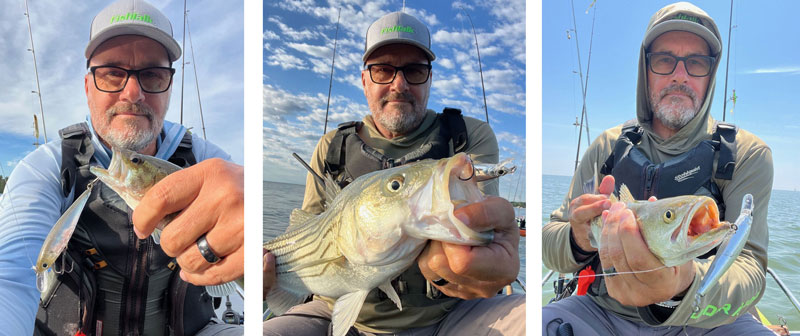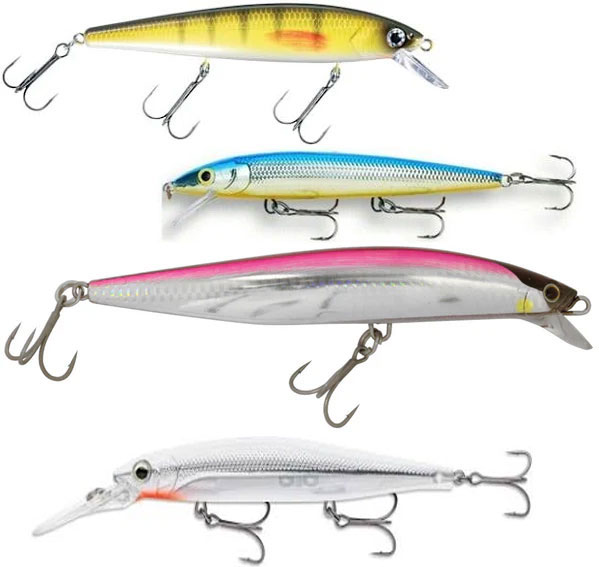If you read the FishTalk fishing reports on a regular basis there’s a good chance you’ve seen the term “jerkbait” pop up plenty of times, and if you want to catch more, bigger fish, jerkbaits definitely belong in your arsenal. These slender hard baits come in many different shapes, sizes, and forms, and there will be times when a jerkbait out-catches just about any other offering.

What is a Jerkbait?
This is actually a rather tough question to answer, because there are so many different forms of the lure and there’s no “official” definition. The term doesn’t exactly appear in sources like Merriam-Webster. But it does show up in the Wiktionary defined as “a type of fishing lure having a swimbait-like slender body that resembles a small baitfish, a short steeply angled bill, and usually two or sometimes three treble hooks.”
That’s not a terrible definition, though we’d argue about the treble hooks (if it does have them switching for inline singles will make life easier for both you and the fish). The bottom line? You could call just about any hard bait with a long, thin profile and a bill a jerkbait without being too far off base. Some anglers and some lure manufacturers might also call a lipless lure a jerkbait, while others would switch to the term twitchbait. Some anglers and manufacturers might call two very similar lures either jerkbaits or crankbaits, though most will agree that lures with deeper lips and squat bodies are cranks. And then there’s the term stickbait, which some people apply to all of the above and others use to describe some soft plastic versions of similar lures. The bottom line? It’s all open to interpretation, so don’t get too hung up on it.
That said, there’s one thing all jerkbaits have in common: they’re intended to be retrieved with a mix of cranking and jerking. If it’s called a twitchbait, on the other hand, it’s probably designed to be paused and twitched during the retrieve. And if it’s designed to be reeled back with a steady retrieve it’s probably labeled a crankbait. Note, however, that any mix of these retrieve styles can work better or worse with any shape or size lure on any given day—regardless of what the manufacturer stamped on the label.

How to Fish a Jerkbait
Fishing a jerkbait is pretty darn straightforward: cast it out, then retrieve while giving the rod tip an extra jerk every now and again. What speed, cadence, and rhythm will be most effective changes from day to day according to the fish’s mood. Your best move is to try varying all these different factors until you start getting bites, then try to use the same style unless and until it stops working.
In some scenarios jerkbaits also work great for trolling. Kayak anglers or those fishing from Jon boats often find slow-trolling them to be effective, especially if you hold the rod and give it an extra tug every so often. At speeds over a couple of mph, however, some jerkbaits will roll onto their sides or may spin.
When to Fish a Jerkbait
This is one of the most important questions to ask, because most jerkbaits will run at a specific depth range. Casting a jerkbait that swims two feet beneath the surface won’t do you much good if the fish are sitting on bottom 20’ below. The bottom line? Try fishing a jerkbait whenever the depth range of the fish matches up with the depth range of the lure.
But…different jerkbaits run at different depths. Some sink, some float, and some are neutrally buoyant. Sinkers allow you to cast out and count before you begin retrieving, to get an approximation of the running depth. Floaters will dive to a specific depth then float back towards the surface when you pause. And neutrally buoyant jerkbaits will dive to a specific depth right after you begin retrieving. With most of these, a couple of hard cranks on the reel will get them to that depth and they’ll stay there for most of the retrieve, until line angle pulls them back up towards the surface.
This is where you, dear angler, need to have a good understanding of your gear—and of the fish. You’ll need to know which jerkbait in the box runs shallow and which runs deep. Then, match that up with your best guess as to what depth the fish are likely to be found considering the time of year, conditions, nearby structure, and bait. Simple… right?